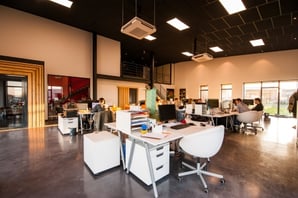3 trends for today’s office buildings: Flexibility and health are top priorities
 When the COVID-19 pandemic hit, remote work became a way of life. More than two years later, companies continue to realize the benefits that a flexible work location can have on employee productivity. And with 83% of workers preferring a hybrid model, leaders also realize how offering hybrid options can retain and attract talent.
When the COVID-19 pandemic hit, remote work became a way of life. More than two years later, companies continue to realize the benefits that a flexible work location can have on employee productivity. And with 83% of workers preferring a hybrid model, leaders also realize how offering hybrid options can retain and attract talent.
With this shift, more and more companies are reworking their spaces. In many cases, companies are looking for ways to maintain an office with a smaller footprint. Other companies that want to reinvigorate collaboration that thrives in person are also looking at ways to accommodate workers who seek flexibility and comfort in the office.
Here are a few things to keep in mind when making decisions about corporate office space in 2022.
- Shared spaces
Some companies are looking to ditch a dedicated building for a multi-tenant office building. For others, coworking facilities may offer a solution. Working in a shared space offers companies a lower-cost option, and being among other tenants can create opportunities to cut costs even more through community amenities and facilities, including restrooms, conference rooms, and meeting spaces.
- Flexible spaces
Companies are implementing more flexibility within their spaces. For instance, Google offers “team pods” – each which have chairs, desks, whiteboards, and storage units that users can move and easily rearrange. Google’s mobile meeting rooms, called "campfires,'' have a semicircle setup and accommodate off-site workers via screens. For this level of flexibility to be effective, buildings must have agile space to accommodate movement and reconfiguration.
- Healthy buildings (and people)
A CNBC report addressed how the pandemic influenced healthier building design. People are paying more attention to their surroundings and how they impact their health. Ventilation and air quality are part of the conversation. And so is ambiance. As a result, building developers are turning to more sustainable material. Buildings are incorporating more outdoor workspace, such as terraces. Buildings are bringing more nature indoors – for instance, incorporating green walls with plants into design and adding indoor water features. This green building trend is likely to accelerate in office design, Lucas Mearian claims in a Computerworld story analyzing the future of work.
If you’re looking for a strategic partner to help bring your next flexible, healthy commercial real estate project to life, contact Compass Group today.
Topics: construction industry
